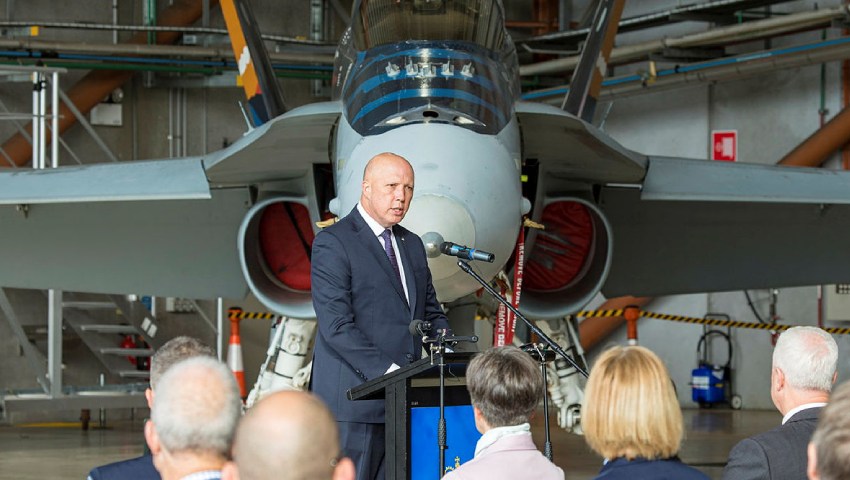The Boeing-built aircraft have officially been retired after over 30 years of service with the ADF.
To continue reading the rest of this article, please log in.
Create free account to get unlimited news articles and more!
The Royal Australian Air Force’s fleet of F/A-18A/B Classic Hornets will no longer take to the skies for military operations, with the fleet officially farewelled during a ceremony at RAAF Base Williamtown.
The farewell was attended by a number of dignitaries, including Minister for Defence Peter Dutton, Chief of the Air Force, Air Marshal Mel Hupfeld, AO, DSC, and Air Commander Australia Air Vice-Marshal Joe Iervasi, AM, CSC.
The F/A-18A/B Hornets have been operated by Number 75 Squadron, RAAF Base Tindal, and Number 3 and 77 Squadron, RAAF Base Williamtown since arriving in June 1984.
The jets have been deployed on a number of key military operations, most notably the NATO-led mission following the 9/11 terrorist attack in the US.
Missions included the safeguarding of the US air base in Diego Garcia from where operations in Afghanistan were launched, and its deployment in Iraq, where it attacked enemy targets and provided air cover for the SAS.
The Classic Hornets also flew more than 1,900 missions against Islamic extremist group Daesh.
Minister Dutton reflected on the fleet’s contribution to the defence of Australia’s interests at home and abroad.
“While the Classic Hornet will no longer take to our skies, the fighter and attack aircraft will remain in the memories of those who flew and maintained it,” he said.
“The distinct, pencil-like nose and cockpit. The unmistakable roar of its F404 engines and the way it nimbly rolled and banked.
“Unquestionably, the Hornet has been an exceptional aircraft. Exceptional in its own right, but all the more exceptional because it’s been crewed and cared for by exceptional people…”
The defence minister went on to thank both military and industry personnel who crewed and serviced the aircraft over the life of the fleet.
“In flying and fixing the F/A-18 Hornet, these men and women – past and present – contributed to mission success, time and again,” he said.
“And with every successful mission, they have contributed to the most purposeful, noble and righteous goals: Standing against evil, preserving peace, keeping Australia safe and secure — we know that these goals will never change and that the values that you adhere to will be those that are adhered to for generations to come.”
RAAF chief, Air Marshal Mel Hupfeld, said the aircraft will be an important piece of Australian aviation history.
“It is quite fitting that in Air Force’s Centenary year we say goodbye to the Classic Hornet, a fighter jet that has been an integral part of Australia’s defence capability for more than three decades,” he said.
Air Marshal Hupfeld personally commanded the contingent of 14 Hornets and personnel from No. 75 Squadron, which deployed to Iraq under Operation Falconer in February 2013.
“This was the first operational combat deployment of Australian fighters since the Korean War, and our aviators and aircraft performed above expectations,” he noted.
Air Commander Australia AVM Joe Iervasi, AM, CSC, also an experienced F/A-18A/B pilot, reflected on the Classic Hornet’s most recent operational deployment against Daesh forces.
“Once again performing above expectations, on Okra the Classic Hornets flew 1937 missions, accumulating 14,780 flying hours, and delivering approximately 1,600 munitions,” AVM Iervasi said.
The multi-role fighter aircraft are being replaced by a fleet of 72 Lockheed Martin-built F-35A Lightning II aircraft.
“While I’m sad to see this incredible aircraft end its role as a sentinel of Australian skies, it’s an exciting time for Air Force as we enter our second century with the F-35A delivering combat air power as part of a networked joint force, to assure the ADF’s ability to deter or defeat threats to Australia’s interests,” AVM Iervasi added.
The RAAF recently received three new F-35 jets, taking the total size of the existing fleet to 44.
The new aircraft touched down in RAAF Base Williamtown, where these were accepted by No. 77 Squadron.
This was the last delivery for the 2021 calendar year.
The Commonwealth government has ordered 72 F-35A aircraft under the Joint Strike Fighter program.
All 72 jets are expected to be fully operational by 2023, with an option to expand the fleet to a maximum of 100 aircraft.
[Related: New F-35As delivered to RAAF]

 Login
Login







